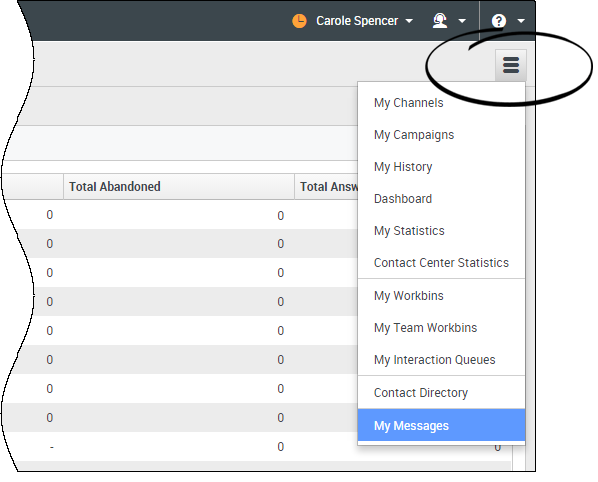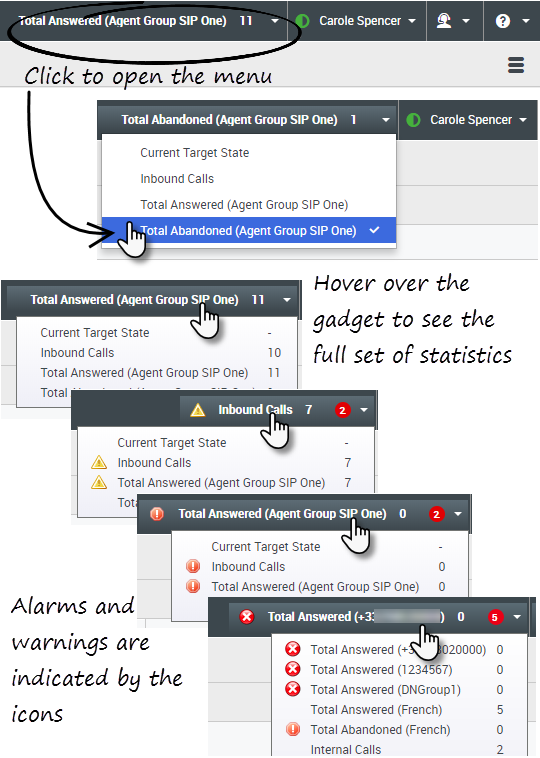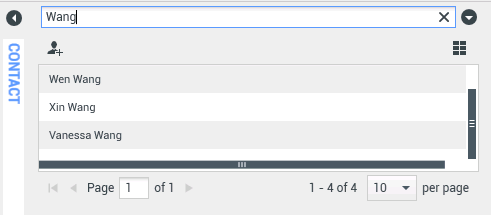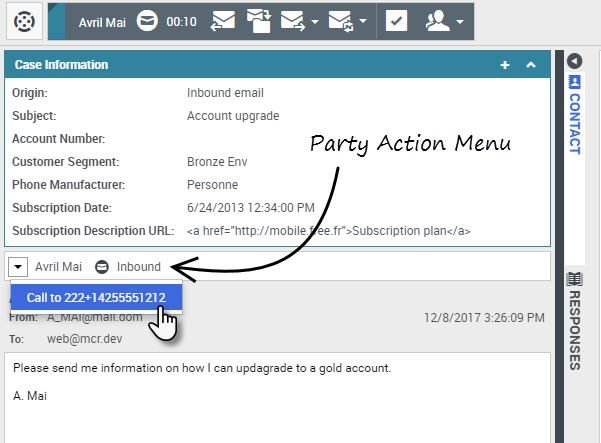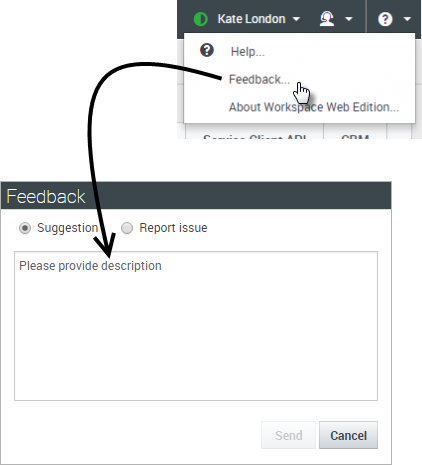Having trouble finding your way around Agent Desktop? If you need help identifying a button or field, hold your mouse pointer over it to reveal a tooltip.
Do you use a screen reader? Do you navigate Agent Desktop using a keyboard? You can find out all about it here!
Main view
The main view lets you access the most common features that you use every day, such as managing your channels, campaigns, KPIs, workbins contacts/customers, and messages.
Some of the tabs include:
- My Channels — Set your status on individual channels, such as voice, chat, and email.
- My Campaigns — View and manage your Outbound campaigns.
- My Statistics — View your statistics (KPIs) and alerts.
- Contact Center Statistics — View the latest statistics and alerts for your contact center.
Watch the video for a quick tour of the Agent Desktop main view.
Supporting views
Contact Center Statistics and KPIs
There are three places where you can view and track your performance and the performance of your contact center:
- The Statistics Gadget in the main menu bar
- The Contact Center Statistics tab in My Workspace
- The My Statistics tab in My Workspace
Note: Some or all of these features might not be available in your environment.
Statistics Gadget
The Statistics Gadget helps you to stay up to date on certain key statistics. Your administrator decides which statistics are available for you to view.
The Statistics Gadget displays one statistic at a time, giving you the current status of service level, number of calls waiting, number of calls you have handled, and so on.
The red circle with the number tells you how many alarms currently apply to the statistics being evaluated by the gadget.
If more than one statistic has been assigned to the gadget, click it to open a list of currently available statistics and select a different one to display. A check mark is displayed next to the current statistic.
Here are the icons that you might see in the Statistics Gadget, the Contact Center Statistics tab, and the My Statistics tab:
- A worst icon is displayed if the evaluation of the performance is the worst of your group (
 ).
).
- An error icon is displayed if the evaluation of the performance is below the expected error level for the KPI (
 ).
).
- A warning icon is displayed if the evaluation of your performance for the KPI goes beyond the expected warning level for the KPI (
 ).
).
To see all of the statistics available for your contact center or for yourself (all your KPIs), click the appropriate tab in My Workspace. You can also choose these tabs from the Available Views (![]() ) menu.
) menu.
Contact Center Statistics tab
The items displayed on this tab are statistics for Routing Points, Queues, and other contact center fascilities.
The Contact Center Statistics tab displays statistics that summarize the state of various conditions, such as waiting time, calls in queue, average maximum waiting time, service level, and answered and abandoned calls, that are monitored by your contact center.
Click the Contact Center Resource column head to change the sort order of the resources.
My Statistics tab
This tab displays the list of your Key Performance Indicators (KPIs).
The KPIs that are displayed are set up by your system administrator. The statistics might be for your agent group rather than for you personally.
Click the Objects column heads to change the sort order of the KPIs.
Quick Search
In the Quick Search field, you can enter the name or other information, such as a phone number or email address, of a contact, then click the magnifying-glass icon to begin the search of the contact database.
Chronology slider
The chronology slider lets you search the contact history for interactions that took place within a certain time period. The slider has four positions:
- All—Search the entire database from the most recent interaction back to the earliest interaction
- Last Month—Search the database from the most recent interaction back to one month ago
- Last Week—Search the database from the most recent interaction back to one week ago
- Last Day—Search the database from the most recent interaction back to one day ago
Page controls
Page through the list of search results by doing any of the following:
- Go to the Next Page (
 )
) - Go to the Previous Page (
 )
) - Go to First Page (
 )
) - Specify the number of items that are displayed on each page by using the per page drop-down list.
List and Grid views
The List view displays an unsorted list of all of the contacts in the contact database that match the search criteria.
Grid mode results are returned in tabular form and sorted according to the default search field, such as Last Name. The Grid view can be used to help to refine your search by sorting the results.
Click a column head in the Grid view to sort the list based on that criterion. Click a column head a second time to switch between ascending and descending sort order.
Show/Hide panel details
Click the Show Details Panel on Bottom/Hide Details Panel button to choose one of the following views:
Interaction Bar
The Interaction Bar is displayed in the main view whenever you have one or more active interactions. If you have multiple active interactions, only the tools for the current active interaction are displayed. The toolbar for other active interactions collapse until you click them to make them current.
Each interaction is represented by a control bar. You can use the control bar to perform basic actions that are specific to the interaction type, such as ending a call.
- Click the control bar for an interaction to give it the focus. All other open interactions are collapsed to the Interaction Bar.
- Click the small colored bar on the left of the interaction control to toggle between pinned mode and floating mode. In floating mode, other open views appear dimmed behind the interaction view.
Entries in the Interaction Bar flash (or blink) when specific events occur that might require your immediate attention.
Tip: To allow for the maximum space in the Interaction Bar, when you are handling an interaction, the Team Communicator is reduced to a button.
Team Communicator
Team Communicator lets you find someone in your company's internal directory (such as a team member, a routing point, or an agent group), and sometimes someone outside your company, such as an external resource person or even a customer contact. It's useful for getting help or consulting with someone while working with an interaction.
To start a call or email interaction, just click in the Team Communicator search field and start typing a name, number, or email address.
You can also filter the search results:
 to search all contacts
to search all contacts to search your favorites
to search your favorites to search recent contacts
to search recent contacts to group (or ungroup) your results by category or type
to group (or ungroup) your results by category or type
If you miss a call, the clock button changes to orange, like this: ![]() . Click it to display any missed calls. If you hover your mouse pointer over the contact entry, a tooltip displays the missed call information, including date, time, and known contact details.
. Click it to display any missed calls. If you hover your mouse pointer over the contact entry, a tooltip displays the missed call information, including date, time, and known contact details.
Tip: When you close the Team Communicator, or if you switch the filter to All contacts or Favorite contacts, the Recent button changes back to white if you have viewed your recent and missed calls, or if you have called back all of your missed calls.
Watch the video for a short demonstration of how to use Team Communicator.
The Party Action menu is a part of every interaction. You can use it during an interaction to launch a secondary interaction. For example, while you are handling an email interaction from a contact, you can use the Party Action menu to call the contact if their phone number address is stored in your corporate database.
How to provide feedback when something goes wrong
Sometimes web-based applications don't work as expected. There might be network connection issues, or the system that sends you phone calls, emails, and chats might be slow or behaving in odd ways. Sometimes the sound quality of a phone call is bad. Sometimes an error message is displayed on your desktop.
These and other issues are problems that you should report to your supervisor. Open the Help menu and select Feedback to open the Feedback window. Choose the type of feedback that you want to give, either a suggestion or to report an issue, describe the problem or suggestion by typing in the text box, then click Send to submit your feedback. This information, along with logs about what you were doing in your most recent Agent Desktop session, are sent to Genesys and are available to Customer Care for later reference.
If for some reason Agent Desktop becomes disconnected from your network and you have to close your browser and launch a new one to log in again, Agent Desktop automatically opens the Feedback window to let you write a report about the disconnection problem immediately.
Once a feedback report is logged to you as a supervisor, contact Genesys Customer Care as soon as possible to provide the reporting user's name and DN at the time of the incident, as well as the approximate time the incident occurred. The Customer Care agent should be able to retrieve the relevant log to determine what the issue might have been.
Agent Desktop lets you navigate the interface entirely by keyboard. This means that you don't have to use a mouse to activate different features or select buttons.
It also means that you can use a screen-reader application to perform all the functions you need.
Whenever an event happens in Agent Desktop, like you get a new interations or an error message is displayed, Agent Desktop makes a sound to alert you.
All the different ways that you can use the keyboard and a screen-reader to move around are described in this section.
Agent Desktop lets you use keyboard shortcuts combinations for some common actions. Ask your administrator for a list of the shortcuts that are set up for Agent Desktop.
Shortcut key combinations
OS shortcuts
The computer operating system also has shortcut keys to let you copy, cut, paste, undo, delete, find, maximize window, minimize window, open menu and select command, switch application, cancel, change focus, and so on. Consult your operating-system documentation for a list of supported keyboard shortcuts.
Agent Desktop shortcut keys
Agent Desktop supports three shortcut key combinations that you can use to make you more productive. These are the default shortcuts (your administrator might have set up different shortcuts for you):
- Alt+N — Jump to the next interaction if you have multiple interactions open
- Alt+B — Jump to the previous interaction if you have multiple interactions open
- Alt+L — Jump to the last error message that you received
If you do not use a mouse or if you are using a device for accessibility that needs keyboard navigation, you can still use all the Agent Desktop features. Many expert users prefer to use keyboard navigation to maximize productivity.
Colors and appearance change as you select different items on the Agent Desktop. For example, buttons change color and menus open with the current selection highlighted by color.- Tab—Moves your focus to the next menu, field, button, view, and so on.
- Shift + Tab—Moves your focus to the previous menu, field, button, view, and so on.
This table shows you the keyboard shortcuts that let you control Agent Desktop without using a mouse.
| Shortcut | Description |
|---|---|
| Left Arrow |
|
| Right Arrow |
|
| Up Arrow | Move up in lists and menus. |
| Down Arrow | Move down in lists and menus. |
| Alt+Down Arrow | Open a selected drop-down list. |
| Enter |
For a modifiable list, apply the edit mode, or validate the modification. For a button, execute the associated action. For a menu item, execute the associated action. |
| Space | For some controls, select or clear the check box that has the focus. |
| Escape | For a modifiable list, cancel the edit mode. |

